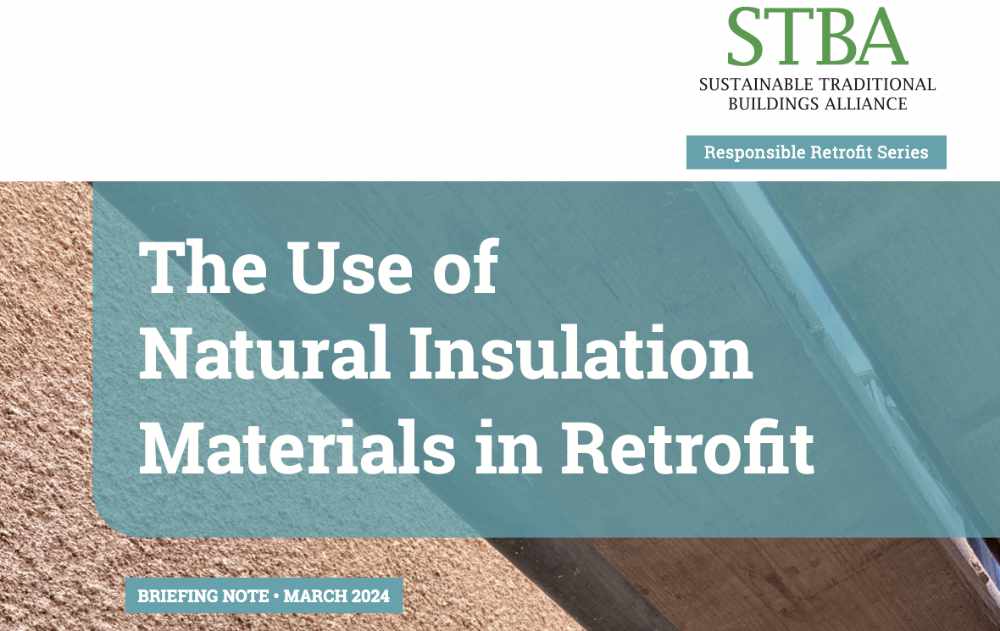Natural materials for retrofits
Contents |
[edit] Championing natural materials to de-risk retrofit
In a new paper, the Sustainable Traditional Buildings Alliance (STBA), which is hosted by the Sustainable Development Foundation (SDF), has identified a number of barriers to best practice retrofit of traditional solid wall buildings, and calls for steps to be taken to remove these barriers, facilitate sustainable retrofit, and ensure the use and enjoyment of our heritage buildings for years to come.
25% of the UK’s building stock is of traditional construction, meaning they are solid-walled and rely on a vapour-open strategy to manage moisture. For these buildings, the unconsidered use of modern impermeable materials can introduce a risk of moisture accumulation and resultant damp and mould.
The paper, The Use of Natural Insulation Materials in Retrofit, explores the energy and carbon characteristics of natural materials, their moisture handling characteristics, and the regulatory context.
On the basis of its analysis, it calls for five actions from government that will help enable best practice retrofit of traditional buildings. The recommendations are to:
- Eliminate the requirement for a 25-year guarantee on solid wall insulation from current Trustmark lodgment rules. Consider introducing a requirement for a 10-year guarantee, or use public funds to expedite longer-term guarantees for natural materials.
- Work with the insurance industry to help them understand the ways in which natural materials can help de-risk retrofit.
- Ensure that the Government’s own guidance on internal wall insulation across all typologies is well understood by all relevant policy officers.
- Establish a broad range of metrics for retrofit materials, to encompass: resource scarcity, sequestered carbon, embodied energy, water use and embodied pollution. EPDs (Environmental Performance Declarations) or Materials Passports could be considered as a starting point.
- Establish a broad range of metrics for retrofit, including benefits to health, welfare, net energy savings, water efficiency and sustainable drainage, and include wider community benefits such as employment, green spaces, and social cohesion.
This article appears on the SDF website as 'Championing natural materials to de-risk retrofit' from April 2024.
[edit] About SDF
The Sustainable Development Foundation aims to drive the property and construction industry towards exemplary sustainability practices. In order to achieve this, the SDF has two main roles: as a Think Tank and as part of an Alliance.
For further information visit: https://sdfoundation.org.uk/
[edit] About STBA
The Sustainable Traditional Buildings Alliance is a collaboration of organisations that acts as a forum for sustaining and improving solid-wall buildings.
The STBA develops policy, guidance and training to minimise risks and maximise benefits to traditional buildings and their owners with a focus on five key areas; the health of the occupants, the health and durability of the building fabric, the energy consumption attributed to the building/occupant, the impact on our communities and culture and the impact on the natural environment
For further information visit: https://stbauk.org/
[edit] Related articles on Designing Buildings
- Definitions of retrofitting.
- Energy efficiency of traditional buildings.
- Energy efficiency retrofit training videos.
- Energy Performance Certificates.
- Fabric first.
- Government urged to include home energy retrofits in Industrial Strategy.
- Home Energy Masterplan.
- Households Declare.
- How to deal with retrofit risks.
- National Retrofit Strategy NRS.
- New energy retrofit concept: 'renovation trains' for mass housing.
- PAS 2035.
- PAS 2038:2021 Retrofitting non-domestic buildings for improved energy efficiency.
- Refurbishment.
- Renovation.
- Renovation v refurbishment v retrofit.
- Retrofit and traditional approaches to comfort.
- Retrofit coordinator.
- Retrofit, refurbishment and the growth of connected HVAC technology.
- Retrofitting solar shading.
- Shallow retrofit.
- Step-by-step retrofit.
Featured articles and news
Restoring Great Yarmouth's Winter Gardens
Transforming one of the least sustainable constructions imaginable.
Construction Skills Mission Board launch sector drive
Newly formed government and industry collaboration set strategy for recruiting an additional 100,000 construction workers a year.
New Architects Code comes into effect in September 2025
ARB Architects Code of Conduct and Practice available with ongoing consultation regarding guidance.
Welsh Skills Body (Medr) launches ambitious plan
The new skills body brings together funding and regulation of tertiary education and research for the devolved nation.
Paul Gandy FCIOB announced as next CIOB President
Former Tilbury Douglas CEO takes helm.
UK Infrastructure: A 10 Year Strategy. In brief with reactions
With the National Infrastructure and Service Transformation Authority (NISTA).
Ebenezer Howard: inventor of the garden city. Book review.
The Grenfell Tower fire, eight years on
A time to pause and reflect as Dubai tower block fire reported just before anniversary.
Airtightness Topic Guide BSRIA TG 27/2025
Explaining the basics of airtightness, what it is, why it's important, when it's required and how it's carried out.
Construction contract awards hit lowest point of 2025
Plummeting for second consecutive month, intensifying concerns for housing and infrastructure goals.
Understanding Mental Health in the Built Environment 2025
Examining the state of mental health in construction, shedding light on levels of stress, anxiety and depression.
The benefits of engaging with insulation manufacturers
When considering ground floor constructions.
Lighting Industry endorses Blueprint for Electrification
The Lighting Industry Association fully supports the ECA Blueprint as a timely, urgent call to action.



















